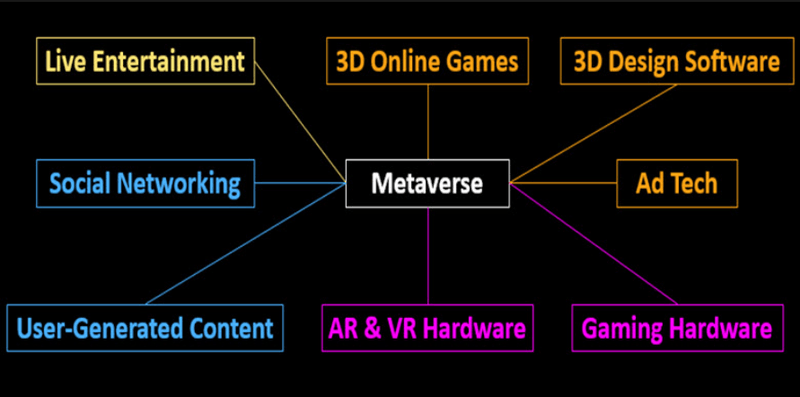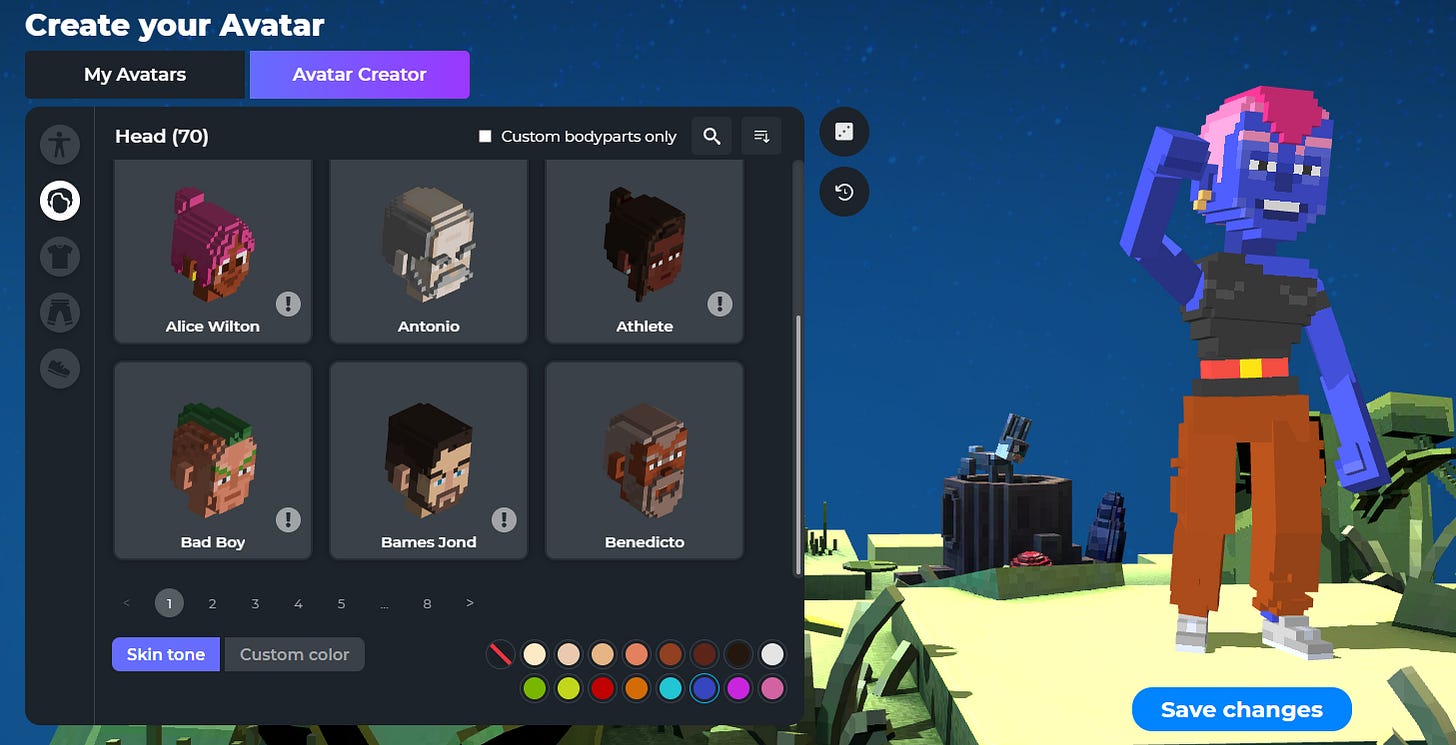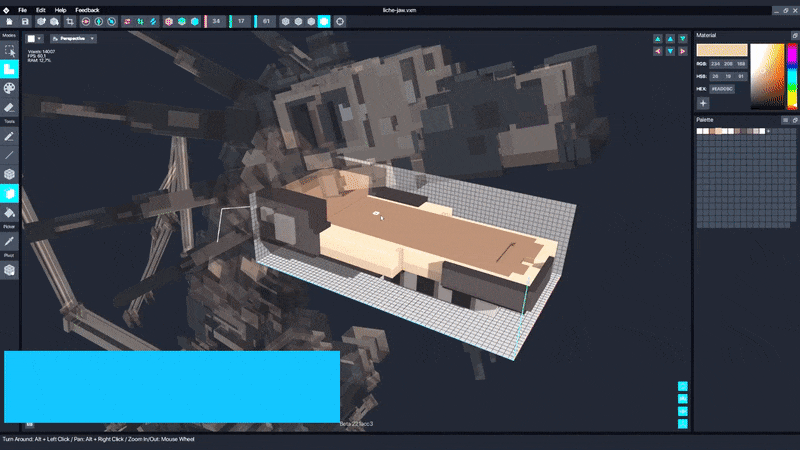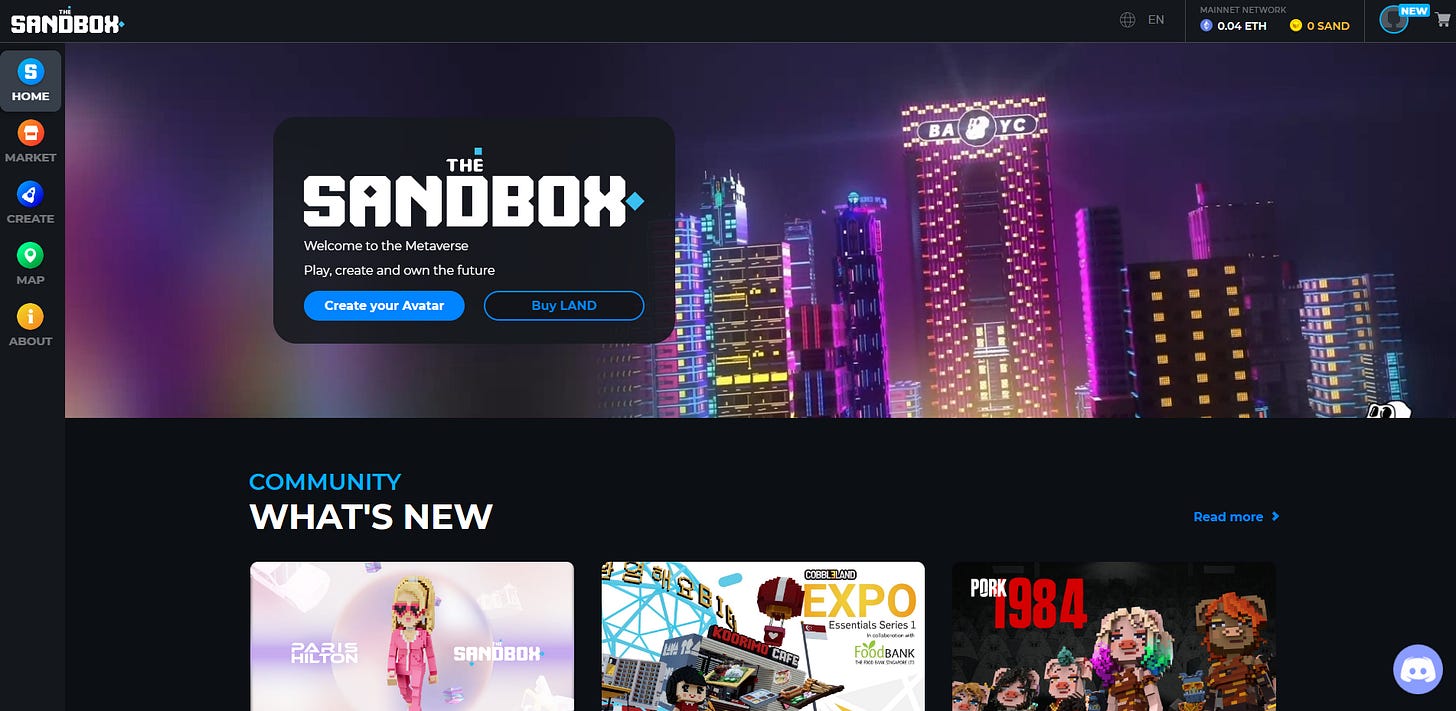The Sandbox
Market Recap
Ethereum Jumps On Successful Testnet Merge
The Sandbox
Last week we began a Metaverse series, starting with Decentraland. Decentraland was one of the first blockchain-based Metaverses to emerge, but it sure wasn't the last. We have seen several emerge since it launched, and no other Metaverse has offered it competition quite like The Sandbox.
As the Metaverse comes into the mainstream, and we see the competition between centralised and decentralised heat up, it is worth exploring the different approaches and competitors that exist.
The Sandbox has offered an alternative to Decentraland with its own unique features, looks and token. However, before we jump in, let us recap what a Metaverse is.
What is a Metaverse?
There is no set definition of what a Metaverse is; that is why it can appeal to so many people for different reasons. However, it generally is the broad shift in how we interact with technology and the environment around us. Virtual Reality (VR) and Augmented Reality (AR) are the two technologies that generally characterise a Metaverse.
The term originated from a 1992 science fiction novel called Snow Crash and combined the two words "meta", a Greek prefix for more comprehensive or transcending and "universe". This gives a general idea as to what it can be, a world or universe that transcends our own in some capacity. This will be through the use of technology that enables us to have new experiences and interact in ways not possible in our current environment. It will be an internet-based three-dimensional world.
Through the use of blockchain, we can create Metaverses that are owned and governed by their token holders. They can directly affect the world built around them while owning and using those assets as they see fit. The Sandbox makes this a reality and so far has positioned itself as a leader in the blockchain-based Metaverse.
What is The Sandbox?
The Sandbox is a VR Metaverse powered by the Ethereum and Polygon blockchains. Within The Sandbox, users are free to create, experience and monetise their content and applications. The Sandbox has a different start to that of Decentraland in that it was founded in 2011 by Arthur Madrid and Sébastien Borget as a traditional gaming application. It had no relation to a blockchain and definitely didn't use smart contracts, as they only became a reality when Ethereum launched in 2015. Nevertheless, The Sandbox and The Sandbox Evolution gained significant traction and had over 40 million downloads across Android and iOS before the game's publisher Pixowl decided to move to a blockchain-based ecosystem in 2018. This provided The Sandbox with a solid base of followers before they had even launched, which is a strategy we may see being replicated in the future by other gaming brands as a differentiator.
The Sandbox started selling off parcels of land in their Metaverse in December 2019. They also conducted a Seed Round where they raised $4.21 million and did an Initial Exchange Offering (IEO) on Binance in August 2020, where they raised an additional $3m. This provided them with enough capital to continue building out their Metaverse, and since then, it has gone from strength to strength. They have recently conducted subsequent funding rounds where they went on to close a Series B led by SoftBank in November 2021, where they raised $93 million.
The Sandbox currently has around 165 partnerships with well-known individuals and brands such as Warner Music Group, HSBC, Ubisoft, Gucci Vault, Adidas, Deadmau5, Steve Aoki, Richie Hawtin, The Smurfs, Care Bears, Atari, Zepeto and CryptoKitties.
With funding behind them and strong partnerships, The Sandbox has managed to firmly position itself as a leading blockchain-based Metaverse.
How Does The Sandbox Work?
The Sandbox has several assets, tokens and components that create the current user experience. The number of in-game assets is greater than in Decentraland, and the graphics are more similar to Minecraft.
In-Game Assets
There are several in-game assets that people can collect and trade:
SAND Token
ASSET Token
LAND Token
GEMs
CATALYSTs
SAND Token
The SAND token is the primary utility token and currency of The Sandbox Metaverse. It is used for all transactions and is built on the ERC-20 standard, meaning it is fungible.
As the above image suggests, the token has a wide variety of uses within the Metaverse. It will be used for buying and selling in-game NFTs such as LAND and ASSETs from the marketplace. You can stake it to earn GEMs and CATALYSTs, which are required for ASSET creation. You will also need it if you plan to participate in the Metaverse's governance.
ASSET Tokens
ASSET tokens can be divided into three categories: Entity, Equipment and Block.
Entity
These are in-game items such as a tree, building or anything else built on your LAND.
Equipment
These are in-game wearable items such as clothes and accessories.
Block
There will be basic blocks that a user can create with the Game Maker tool provided by developers; however, users will also be free to create their own unique blocks which they are free to monetise on the Marketplace.
These ASSET tokens are created using the ERC-1155 standard (co-created by The Sandbox team with the Enjin project), which means they can be semi-fungible tokens and allows for batch transfers where ERC-721 doesn't.
LAND Tokens
Like Decentraland, LAND represents the traversable space within The Sandbox ecosystem; it is their digital real estate. It is built on the ERC-721 standard. This means that they are non-fungible and have unique properties that distinguish them from each other. This is important because, as with land in the real world, it needs to be identifiable and have a unique location; each plot of LAND is identifiable by its coordinates on the map.
Each plot of LAND in The Sandbox represents a 96x96 meter parcel in the game. Currently, a capped total of 166 464 parcels of LAND are available. Their value can vary significantly depending on where they are located; proximity to different locations in The Sandbox can make LAND much more desirable. For example, areas close to the Warner Music Group planned concert stage have started demanding higher premiums. By acquiring LAND, you have the exclusive right to build and monetise it as you see fit. You can create and play games, earn tokens by charging others who want to play the games, and host contests or events. You can even rent out your LAND to people who may want to build on it and monetise it. As a LAND owner, you are also granted governance rights in The Sandbox Metaverse.
When you have two or more adjacent LAND parcels, you can also create ESTATEs which means you can build more on that LAND and potentially earn more income.
GEMs
GEMs are given as rewards for staking SAND on LAND; alternatively, you can purchase them through the Marketplace. GEMs are desirable because when you are creating in-game ASSETs, you are required to burn them to give ASSETs additional attributes. The more attributes an ASSET has, the more scarce and, therefore, desirable and valuable they are within the Metaverse.
Each type of GEMs available does different things:
One GEM can provide 25 attribute points to an ASSET, and when combined with CATALYSTs, you can use up to four GEMs for a total of one hundred attribute points.
CATALYSTs
CATALYSTs define your ASSET's tier and scarcity in the Marketplace. There are four different levels of CATALYSTs: Common, Rare, Epic and Legendary. Each level allows an additional GEM to be added and therefore increases the attributes of the ASSET; it also affects the number of these ASSETS you can create.
The higher the tier, the more powerful and scarce the in-game ASSET you create will be.
Architecture
The Sandbox comprises several components that make it work and create the in-game experience.
Ethereum/Polygon Smart Contracts
The Sandbox uses Ethereum and Polygon smart contracts to maintain a ledger of ownership of SAND, LAND, GEM and CATALYST tokens; it also keeps a record of the in-game ASSET tokens and where they are placed on parcels and blocks. This is one of the core premises of a decentralised Metaverse, as you own the assets yourself and can trade them as you see fit.
AWS
The Sandbox uses AWS as its backend to create the UI you see when interacting with the Metaverse. As you traverse the world and create ASSETs, computers need to render the parcel of land and items you see while playing the game. The Sandbox also uses IPFS to store all ASSET-related information. Once an ASSET is minted, The Sandbox releases the ASSET onto the IPFS server, where it can now be traded freely as a smart contract records the hash of it.
The Sandbox Features
The Sandbox has created several handy tools that reduce the complexity of creating your own ASSETs and Avatar.
The Sandbox Avatar
Your avatar represents you in the Metaverse. When you begin your journey, creating your avatar is your first step. The Sandbox has created an intuitive and easy way to make your avatar.
Initially, when you start, you have a wide selection of wearables and distinctive features. Within The Sandbox, you also have a variety of extra accessories and items that have varying levels of scarcity that can be purchased or won through various games. These can be accessed through the Marketplace, where you are free to trade these items. Premium wearables have already found a fit within the gaming and Metaverse sectors, with people paying hundreds of thousands of dollars for scarce in-game items. Traditional companies like Adidas have joined The Sandbox and created limited edition wearables that people can use for their avatars.
VoxEdit
Sandbox developers have released a 3D modelling package that allows users to easily model and create 3D objects, including people, animals, tools and foliage. They have created an intuitive UI that reduced the complexity one would usually experience when creating these types of 3D models by yourself.
The VoxEdit software is currently the only software capable of exporting assets to The Sandbox Marketplace. Anyone is free to create; however, to upload your creations onto the Marketplace, you need to become an artist through their Creator Fund.
Game Maker
Similar to VoxEdit, the developers have provided a tool one can use to design and test experiences and games within the Metaverse. You require no coding knowledge, making the barriers to entry much lower than they would otherwise be.
It is a standalone software that you are required to download in order to start, but once you have, you can edit terrain, place characters, display items, organise buildings, and curate quests, all from a vast library of professional and community-developed resources.
Getting Started With The Sandbox
With a basic overview of what a Metaverse is and how The Sandbox works, we can get started with using it.
It is very simple; nevertheless, what you can do is so comprehensive that it is beyond the scope of this article. Yet, we can start with the basics.
Step 1: Set Up MetaMask Wallet
In order to interact with Ethereum/Polygon and The Sandbox, you require a wallet. Our wallet of choice is MetaMask, but you are free to choose your own Ethereum-compatible wallet. Please find our guide to setting up your own MetaMask wallet here.
Step 2: Visit The Sandbox Website
Visit The Sandbox Website
Make sure you land on "https://www.sandbox.game/en/"
Click Sign In on the top right hand of the screen
Log in with your MetaMask or chosen wallet
You should see the below page:
Step 3: Create Avatar
Click Create your Avatar
You will now be prompted to create an avatar. Feel free to try out different combinations. Also, remember you can purchase new wearables and accessories through the Marketplace.
Step 4: Start Exploring!
Now that you have created your avatar, you can start exploring The Sandbox. You are free to go where you want! It is a free-to-play game, so you aren't required to purchase any LAND or anything else to start your adventure; however, some SAND may help.
Conclusion
The Sandbox has positioned itself as one of the biggest competitors in the blockchain-based Metaverse. It has created strong partnerships with some of the most well-known brands in the world. The world the developers have created is vast and can be explored for hours. They have also implemented ways for users to monetise their products and games effectively and have incentivised big brands to market within their Metaverse. We will continue to see more VR shows and experiences happening within these virtual worlds, and much of this activity points to The Sandbox.
We look forward to seeing how the network develops over time and whether it continues to gain traction and increase user growth.
Next week we will continue exploring the other projects in the Metaverse and gaming sectors. If you have any questions or have trouble using the network, please feel free to reach out and ask us questions. We always look forward to chatting with our readers. Otherwise, please feel free to share this article if you know anyone who is interested in learning more about the Metaverse and The Sandbox.
Notable Articles and News Stories This Week:
Ethereum Closer to PoS After Successful Goerli Testnet Merge
Ethereum testnet Goerli now switched to proof-of-stake (PoS), representing the third and final step before the long-anticipated Merge.
Goerli successfully transitioned to PoS shortly after the network’s total block difficulty crossed 10,079,000 at around 9:45 pm ET.
Two other testnets — Ropsten and Sepolia — ditched proof-of-work (PoW) over the past two months, with Goerli’s version of the Merge only going ahead as those were successful.
Ethereum’s blockchain has now edged closer to a full transition to PoS in what is known as the Merge, designed to pivot the chain to a more environmentally and energy-efficient protocol.
Read more about the merge here
BlackRock Launches Spot Bitcoin Private Trust After Coinbase Partnership
Asset management titan BlackRock has delved a bit deeper into the crypto waters, revealing that it has launched a spot bitcoin private trust for US institutional clients.
“Despite the steep downturn in the digital asset market, we are still seeing substantial interest from some institutional clients in how to efficiently and cost-effectively access these assets using our technology and product capabilities,” the company said in a Thursday statement.
The trust seeks to track the performance of bitcoin.
Read more about the move here
Netherlands Arrests Suspected Tornado Cash Dev Days After US Sanctions
Dutch financial crimes agency FIOD arrested a 29-year-old developer in Amsterdam on Wednesday over suspected involvement in laundering money through crypto mixer Tornado Cash.
FIOD said a team began probing Tornado Cash in June. The investigation is led by the Public Prosecutor’s office.
“Multiple arrests are not ruled out,” the Fiscal Information and Investigation Service said in a statement, adding that the male suspect had been brought before a judge.
Earlier this week, the US Treasury sanctioned Tornado Cash addresses over allegations it laundered $7 billion worth of digital assets since it launched in 2019. That figure matches the total value of funds sent through Tornado Cash since its launch in February last year, per a Dune Analytics dashboard.
Read more about the arrest here
Whilst we all have the option to look, to seek to understand, it’s often easier not to. Bitcoin, Ethereum and distributed ledger technology are complex systems that require significant due diligence. At Etherbridge, we aim to lower the barriers to understanding this fast-growing digital economy.
If you are interested in staying up to date, please subscribe to our newsletter at etherbridge.co
This is not financial advice. All opinions expressed here are our own. We encourage investors to do their own research before making any investments.












